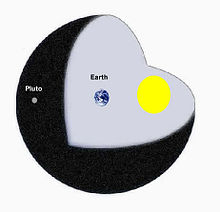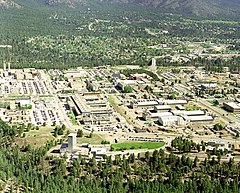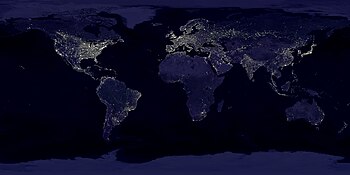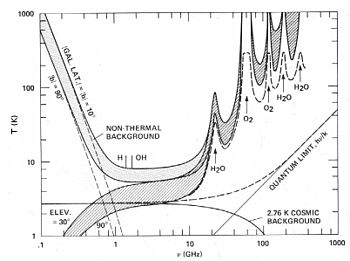A graphical representation of the Arecibo message, humanity's first attempt to use radio waves to actively communicate its existence to alien civilizations
The Fermi paradox, or Fermi's paradox, named after physicist Enrico Fermi, is the apparent contradiction between the lack of evidence and high probability estimates[1] for the existence of extraterrestrial civilizations.[2] The basic points of the argument, made by physicists Enrico Fermi (1901–1954) and Michael H. Hart (born 1932), are:
- There are billions of stars in the galaxy that are similar to the Sun,[3][4] and many of these stars are billions of years older than the Solar system.[5][6]
- With high probability, some of these stars have Earth-like planets,[7][8] and if the Earth is typical, some may have developed intelligent life.
- Some of these civilizations may have developed interstellar travel, a step the Earth is investigating now.
- Even at the slow pace of currently envisioned interstellar travel, the Milky Way galaxy could be completely traversed in a few million years.[9]
Basis
Enrico Fermi (1901–1954)
The Fermi paradox is a conflict between arguments of scale and probability that seem to favor intelligent life being common in the universe, and a total lack of evidence of intelligent life having ever arisen anywhere other than on the Earth.
The first aspect of the Fermi paradox is a function of the scale or the large numbers involved: there are an estimated 200–400 billion stars in the Milky Way[14] (2–4 × 1011) and 70 sextillion (7×1022) in the observable universe.[15] Even if intelligent life occurs on only a minuscule percentage of planets around these stars, there might still be a great number of extant civilizations, and if the percentage were high enough it would produce a significant number of extant civilizations in the Milky Way. This assumes the mediocrity principle, by which the Earth is a typical planet.
The second aspect of the Fermi paradox is the argument of probability: given intelligent life's ability to overcome scarcity, and its tendency to colonize new habitats, it seems possible that at least some civilizations would be technologically advanced, seek out new resources in space, and colonize their own star system and, subsequently, surrounding star systems. Since there is no significant evidence on Earth, or elsewhere in the known universe, of other intelligent life after 13.8 billion years of the universe's history, there is a conflict requiring a resolution. Some examples of possible resolutions are that intelligent life is rarer than we think, that our assumptions about the general development or behavior of intelligent species are flawed, or, more radically, that our current scientific understanding of the nature of the universe itself is quite incomplete.
The Fermi paradox can be asked in two ways.[16] The first is, "Why are no aliens or their artifacts found here on Earth, or in the Solar System?" If interstellar travel is possible, even the "slow" kind nearly within the reach of Earth technology, then it would only take from 5 million to 50 million years to colonize the galaxy.[17] This is relatively brief on a geological scale, let alone a cosmological one. Since there are many stars older than the Sun, and since intelligent life might have evolved earlier elsewhere, the question then becomes why the galaxy has not been colonized already. Even if colonization is impractical or undesirable to all alien civilizations, large-scale exploration of the galaxy could be possible by probes. These might leave detectable artifacts in the Solar System, such as old probes or evidence of mining activity, but none of these have been observed.
The second form of the question is "Why do we see no signs of intelligence elsewhere in the universe?" This version does not assume interstellar travel, but includes other galaxies as well. For distant galaxies, travel times may well explain the lack of alien visits to Earth, but a sufficiently advanced civilization could potentially be observable over a significant fraction of the size of the observable universe.[18] Even if such civilizations are rare, the scale argument indicates they should exist somewhere at some point during the history of the universe, and since they could be detected from far away over a considerable period of time, many more potential sites for their origin are within range of our observation. It is unknown whether the paradox is stronger for our galaxy or for the universe as a whole.[19]
Criticism of logical basis
The Fermi paradox has been criticized as being based on an inappropriate use of propositional logic. According to a 1985 paper by Robert Freitas, when recast as a statement in modal logic, the paradox no longer exists, and carries no probative value.[20]History and name
Los Alamos National Laboratory
In 1950, while working at Los Alamos National Laboratory, Fermi had a casual conversation while walking to lunch with colleagues Emil Konopinski, Edward Teller and Herbert York.[21] The men discussed a recent spate of UFO reports and an Alan Dunn cartoon[22] facetiously blaming the disappearance of municipal trashcans on marauding aliens. The conversation shifted to other subjects, until during lunch Fermi suddenly exclaimed, "Where are they?" (alternatively, "Where is everybody?"). Teller remembers, "The result of his question was general laughter because of the strange fact that in spite of Fermi's question coming from the clear blue, everybody around the table seemed to understand at once that he was talking about extraterrestrial life."[23] Herbert York recalls that Fermi followed up on his comment with a series of calculations on the probability of Earth-like planets, the probability of life, the likely rise and duration of high technology, etc., and concluded that we ought to have been visited long ago and many times over.
Although Fermi's name is most commonly associated with the paradox, he was not the first to ask the question. An earlier implicit mention was by Konstantin Tsiolkovsky in an unpublished manuscript from 1933.[24] He noted "people deny the presence of intelligent beings on the planets of the universe" because "(i) if such beings exist they would have visited Earth, and (ii) if such civilizations existed then they would have given us some sign of their existence." This was not a paradox for others, who took this to imply the absence of ETs, but it was for him, since he himself was a strong believer in extraterrestrial life and the possibility of space travel. Therefore, he proposed what is now known as the zoo hypothesis and speculated that mankind is not yet ready for higher beings to contact us.[25] That Tsiolkovsky himself may not have been the first to discover the paradox is suggested by his above-mentioned reference to other people's reasons for denying the existence of extraterrestrial civilizations.
Michael H. Hart published in 1975 a detailed examination of the paradox,[9] which has since become a theoretical reference point for much of the research into what is now sometimes known as the Fermi–Hart paradox.[26] Geoffrey A. Landis prefers that name on the grounds that "while Fermi is credited with first asking the question, Hart was the first to do a rigorous analysis showing that the problem is not trivial, and also the first to publish his results".[27] Robert H. Gray argues that the term Fermi paradox is a misnomer, since in his view it is neither a paradox nor due to Fermi; he instead prefers the name Hart–Tipler argument, acknowledging Michael Hart as its originator, but also the substantial contribution of Frank J. Tipler in extending Hart's arguments.[28]
Other names closely related to Fermi's question ("Where are they?") include the Great Silence,[29][30][31][32] and silentium universi[32] (Latin for "silence of the universe"), though these only refer to one portion of the Fermi Paradox, that we see no evidence of other civilizations.
Drake equation
The theories and principles in the Drake equation are closely related to the Fermi paradox.[33] The equation was formulated by Frank Drake in 1961 in an attempt to find a systematic means to evaluate the numerous probabilities involved in the existence of alien life. The speculative equation considers the rate of star formation in the galaxy; the fraction of stars with planets and the number per star that are habitable; the fraction of those planets that develop life; the fraction that develop intelligent life; the fraction that have detectable, technological intelligent life; and finally the length of time such communicable civilizations are detectable. The fundamental problem is that the last four terms are completely unknown, rendering statistical estimates impossible.The Drake equation has been used by both optimists and pessimists, with wildly differing results. The original meeting, including Frank Drake and Carl Sagan, speculated that the number of civilizations was roughly equal to the lifetime in years, and there were probably between 1000 and 100,000,000 civilizations in the Milky Way galaxy.[34] Conversely, Frank Tipler and John D. Barrow used pessimistic numbers and speculated that the average number of civilizations in a galaxy is much less than one.[35] Almost all arguments involving the Drake equation suffer from the overconfidence effect, a common error of probabilistic reasoning about low-probability events, by guessing specific numbers for likelihoods of events whose mechanism is not yet understood, such as the likelihood of abiogenesis on an Earth-like planet, with current likelihood estimates varying over many hundreds of orders of magnitude. An analysis that takes into account some of the uncertainty associated with this lack of understanding has been carried out by Anders Sandberg, Eric Drexler and Toby Ord[36], and suggests that with very high probability, either intelligent civilizations are plentiful in our galaxy or humanity is alone in the visible universe, with the lack of observation of intelligent civilizations pointing towards the latter option.
Empirical projects
There are two parts of the Fermi paradox that rely on empirical evidence—that there are many potential habitable planets, and that we see no evidence of life. The first point, that many suitable planets exist, was an assumption in Fermi's time that is gaining ground with the discovery of many exoplanets, and models predicting billions of habitable worlds in our galaxy.[37]The second part of the paradox, that we see no evidence of extraterrestrial life, is also an active field of scientific research. This includes both efforts to find any indication of life,[38] and efforts specifically directed to finding intelligent life. These searches have been made since 1960, and several are ongoing.[39]
Mainstream astronomy and SETI
An artist's depiction of the "little green man" described in the novel Martians, Go Home
Although astronomers do not usually search for extraterrestrials, they have observed phenomena that they could not immediately explain without positing an intelligent civilization as the source. For example, pulsars, when first discovered in 1967, were called little green men (LGM) because of the precise repetition of their pulses.[40] In all cases, explanations with no need for intelligent life have been found for such observations,[41] but the possibility of discovery remains.[42] Proposed examples include asteroid mining that would change the appearance of debris disks around stars,[43] or spectral lines from nuclear waste disposal in stars.[44] An ongoing example is the unusual transit light curves of star KIC 8462852, where natural interpretations are not fully convincing.[45] Although most likely a natural explanation will emerge, some scientists are investigating the remote possibility that it could be a sign of alien technology, such as a Dyson swarm.[46][47][48]
Electromagnetic emissions
Radio telescopes are often used by SETI projects
Radio technology and the ability to construct a radio telescope are presumed to be a natural advance for technological species,[49] theoretically creating effects that might be detected over interstellar distances. The careful searching for non-natural radio emissions from space may lead to the detection of alien civilizations. Sensitive alien observers of the Solar System, for example, would note unusually intense radio waves for a G2 star due to Earth's television and telecommunication broadcasts. In the absence of an apparent natural cause, alien observers might infer the existence of a terrestrial civilization. It should be noted however that the most sensitive radio telescopes currently available on Earth would not be able to detect non-directional radio signals even at a fraction of a light-year, so it is questionable whether any such signals could be detected by an extraterrestrial civilization. Such signals could be either "accidental" by-products of a civilization, or deliberate attempts to communicate, such as the Arecibo message. A number of astronomers and observatories have attempted and are attempting to detect such evidence, mostly through the SETI organization. Several decades of SETI analysis have not revealed any unusually bright or meaningfully repetitive radio emissions.
Direct planetary observation
A composite picture of Earth at night, created with data from the Defense Meteorological Satellite Program (DMSP) Operational Linescan System (OLS). Large-scale artificial lighting produced by human civilization is detectable from space.
Exoplanet detection and classification is a very active sub-discipline in astronomy, and the first possibly terrestrial planet discovered within a star's habitable zone was found in 2007.[50] New refinements in exoplanet detection methods, and use of existing methods from space (such as the Kepler Mission, launched in 2009) are starting to detect and characterize Earth-size planets, and determine if they are within the habitable zones of their stars. Such observational refinements may allow us to better gauge how common potentially habitable worlds are.[51]
Conjectures about interstellar probes
Self-replicating probes could exhaustively explore a galaxy the size of the Milky Way in as little as a million years.[9]
If even a single civilization in the Milky Way attempted this, such
probes could spread throughout the entire galaxy. Another speculation
for contact with an alien probe—one that would be trying to find human
beings—is an alien Bracewell probe.
Such a hypothetical device would be an autonomous space probe whose
purpose is to seek out and communicate with alien civilizations (as
opposed to Von Neumann probes, which are usually described as purely
exploratory). These were proposed as an alternative to carrying a slow speed-of-light
dialogue between vastly distant neighbors. Rather than contending with
the long delays a radio dialogue would suffer, a probe housing an artificial intelligence
would seek out an alien civilization to carry on a close-range
communication with the discovered civilization. The findings of such a
probe would still have to be transmitted to the home civilization at
light speed, but an information-gathering dialogue could be conducted in
real time.[52]
Attempts to find alien probes
Direct exploration of the Solar System has yielded no evidence indicating a visit by aliens or their probes. Detailed exploration of areas of the Solar System where resources would be plentiful may yet produce evidence of alien exploration,[53][54] though the entirety of the Solar System is vast and difficult to investigate. Attempts to signal, attract, or activate hypothetical Bracewell probes in Earth's vicinity have not succeeded.[55]Conjectures about stellar-scale artifacts
A variant of the speculative Dyson sphere. Such large scale artifacts would drastically alter the spectrum of a star.
In 1959, Freeman Dyson observed that every developing human civilization constantly increases its energy consumption, and, he conjectured, a civilization might try to harness a large part of the energy produced by a star. He proposed that a Dyson sphere could be a possible means: a shell or cloud of objects enclosing a star to absorb and utilize as much radiant energy as possible. Such a feat of astroengineering would drastically alter the observed spectrum of the star involved, changing it at least partly from the normal emission lines of a natural stellar atmosphere to those of black body radiation, probably with a peak in the infrared. Dyson speculated that advanced alien civilizations might be detected by examining the spectra of stars and searching for such an altered spectrum.[56][57][58]
There have been some attempts to find evidence of the existence of Dyson spheres that would alter the spectra of their core stars.[59] Direct observation of thousands of galaxies has shown no explicit evidence of artificial construction or modifications.[57][58][60][61] In October 2015, there was some speculation that a pattern of light from star KIC 8462852, observed by the Kepler Space Telescope, could have been a result of Dyson sphere construction.[62][63]
Hypothetical explanations for the paradox
Great Filter Hypothesis
The Fermi paradox can be explained by variants of the Great Filter Hypothesis, which posits that in order for intelligent life to occur and create civilization certain extremely low-probability events, called "great filters" need to occur, essentially "filtering" possible locations of intelligent life to those planets that "won the cosmic lottery", i.e. where these unlikely events did occur. The most commonly agreed-upon low probability event is abiogenesis: the spontaneous generation of the first self-replicating molecular compound by a randomly occurring chemical process. Other proposed great filters are the emergence of eucariotes or of meiosis (both known to have taken many billion years to evolve from the first on Earth) or some of the steps involved in the evolution of a brain capable of complex logical deductions.Extraterrestrial life is rare or non-existent
Those who think that intelligent extraterrestrial life is (nearly) impossible argue that the conditions needed for the evolution of life—or at least the evolution of biological complexity—are rare or even unique to Earth. Under this assumption, called the rare Earth hypothesis, a rejection of the mediocrity principle, complex multicellular life is regarded as exceedingly unusual.[64]The Rare Earth hypothesis argues that the evolution of biological complexity requires a host of fortuitous circumstances, such as a galactic habitable zone, a central star and planetary system having the requisite character, the circumstellar habitable zone, a right sized terrestrial planet, the advantage of a giant guardian like Jupiter and a large natural satellite, conditions needed to ensure the planet has a magnetosphere and plate tectonics, the chemistry of the lithosphere, atmosphere, and oceans, the role of "evolutionary pumps" such as massive glaciation and rare bolide impacts, and whatever led to the appearance of the eukaryote cell, sexual reproduction and the Cambrian explosion.
No other intelligent species have arisen
It is possible that even if complex life is common, intelligence (and consequently civilizations) is not.[65] While there are remote sensing techniques that could perhaps detect life-bearing planets without relying on the signs of technology,[66][67] none of them has any ability to tell if any detected life is intelligent. This is sometimes referred to as the "algae vs. alumnae" problem.[68]Intelligent alien species lack advanced technology
It may be that while alien species with intelligence exist, they are primitive or have not reached the level of technological advancement necessary to communicate. Along with non-intelligent life, such civilizations would be also very difficult for us to detect,[68] short of a visit by a probe, a trip that would take hundreds of thousands of years with current technology.[69] To skeptics, the fact that in the history of life on the Earth only one species has developed a civilization to the point of being capable of spaceflight and radio technology, lends more credence to the idea that technologically advanced civilizations are rare in the universe.[70]It is the nature of intelligent life to destroy itself

A 23-kiloton tower shot called BADGER, fired as part of the Operation Upshot–Knothole nuclear test series.
This is the argument that technological civilizations may usually or invariably destroy themselves before or shortly after developing radio or spaceflight technology. Possible means of annihilation are many,[71] including war, accidental environmental contamination or damage, resource depletion, climate change,[72] or poorly designed artificial intelligence. This general theme is explored both in fiction and in scientific hypothesizing.[73] In 1966, Sagan and Shklovskii speculated that technological civilizations will either tend to destroy themselves within a century of developing interstellar communicative capability or master their self-destructive tendencies and survive for billion-year timescales.[74] Self-annihilation may also be viewed in terms of thermodynamics: insofar as life is an ordered system that can sustain itself against the tendency to disorder, the "external transmission" or interstellar communicative phase may be the point at which the system becomes unstable and self-destructs.[75]
It is the nature of intelligent life to destroy others
Another hypothesis is that an intelligent species beyond a certain point of technological capability will destroy other intelligent species as they appear. The idea that something, or someone, might be destroying intelligent life in the universe has been explored in the scientific literature.[29] A species might undertake such extermination out of expansionist motives, paranoia, or aggression. In 1981, cosmologist Edward Harrison argued that such behavior would be an act of prudence: an intelligent species that has overcome its own self-destructive tendencies might view any other species bent on galactic expansion as a threat.[76] It has also been suggested that a successful alien species would be a superpredator, as are humans.[77][78]Periodic extinction by natural events
New life might commonly die out due to runaway heating or cooling on their fledgling planets.[79] On Earth, there have been numerous major extinction events that destroyed the majority of complex species alive at the time; the extinction of the dinosaurs is the best known example. These are thought to have been caused by events such as impact from a large meteorite, massive volcanic eruptions, or astronomical events such as gamma-ray bursts.[80] It may be the case that such extinction events are common throughout the universe and periodically destroy intelligent life, or at least its civilizations, before the species is able to develop the technology to communicate with other species.[81]Inflation hypothesis and the youngness argument
Cosmologist Alan Guth proposed a multiverse solution to the Fermi paradox. This hypothesis uses the synchronous gauge probability distribution, with the result that young universes exceedingly outnumber older ones (by a factor of e1037 for every second of age). Therefore, averaged over all universes, universes with civilizations will almost always have just one, the first to develop. However, Guth notes "Perhaps this argument explains why SETI has not found any signals from alien civilizations, but I find it more plausible that it is merely a symptom that the synchronous gauge probability distribution is not the right one."[82]Intelligent civilizations are too far apart in space or time
NASA's conception of the Terrestrial Planet Finder
It may be that non-colonizing technologically capable alien civilizations exist, but that they are simply too far apart for meaningful two-way communication.[83] If two civilizations are separated by several thousand light-years, it is possible that one or both cultures may become extinct before meaningful dialogue can be established. Human searches may be able to detect their existence, but communication will remain impossible because of distance. It has been suggested that this problem might be ameliorated somewhat if contact/communication is made through a Bracewell probe. In this case at least one partner in the exchange may obtain meaningful information. Alternatively, a civilization may simply broadcast its knowledge, and leave it to the receiver to make what they may of it. This is similar to the transmission of information from ancient civilizations to the present,[84] and humanity has undertaken similar activities like the Arecibo message, which could transfer information about Earth's intelligent species, even if it never yields a response or does not yield a response in time for humanity to receive it. It is also possible that archaeological evidence of past civilizations may be detected through deep space observations.[85]
A related speculation by Sagan and Newman suggests that if other civilizations exist, and are transmitting and exploring, their signals and probes simply have not arrived yet.[86] However, critics have noted that this is unlikely, since it requires that humanity's advancement has occurred at a very special point in time, while the Milky Way is in transition from empty to full. This is a tiny fraction of the lifespan of a galaxy under ordinary assumptions and calculations resulting from them, so the likelihood that we are in the midst of this transition is considered low in the paradox.[87]
Lack of resources to spread physically throughout the galaxy
Many speculations about the ability of an alien culture to colonize other star systems are based on the idea that interstellar travel is technologically feasible. While the current understanding of physics rules out the possibility of faster-than-light travel, it appears that there are no major theoretical barriers to the construction of "slow" interstellar ships, even though the engineering required is considerably beyond our present capabilities. This idea underlies the concept of the Von Neumann probe and the Bracewell probe as a potential evidence of extraterrestrial intelligence.It is possible, however, that present scientific knowledge cannot properly gauge the feasibility and costs of such interstellar colonization. Theoretical barriers may not yet be understood, and the resources needed may be so great as to make it unlikely that any civilization could afford to attempt it. Even if interstellar travel and colonization are possible, they may be difficult, leading to a colonization model based on percolation theory.[88] Colonization efforts may not occur as an unstoppable rush, but rather as an uneven tendency to "percolate" outwards, within an eventual slowing and termination of the effort given the enormous costs involved and the expectation that colonies will inevitably develop a culture and civilization of their own. Colonization may thus occur in "clusters," with large areas remaining uncolonized at any one time.[88]
If exploration, or backup from a home system disaster, is the primary motive for expansion, then it is possible that mind uploading and similar technologies may reduce the desire to colonize by replacing physical travel with much less-expensive communication.[89] Therefore, the first civilization may have physically explored or colonized the galaxy, but subsequent civilizations find it cheaper, faster, and easier to travel by contacting existing civilizations rather than physically exploring or traveling themselves. This leads to little or no physical travel at the current epoch, and only directed communications, which are hard to see except to the intended receiver.
Human beings have not existed long enough
Humanity's ability to detect intelligent extraterrestrial life has existed for only a very brief period—from 1937 onwards, if the invention of the radio telescope is taken as the dividing line—and Homo sapiens is a geologically recent species. The whole period of modern human existence to date is a very brief period on a cosmological scale, and radio transmissions have only been propagated since 1895. Thus, it remains possible that human beings have neither existed long enough nor made themselves sufficiently detectable to be found by extraterrestrial intelligence.[90]We are not listening properly
There are some assumptions that underlie the SETI programs that may cause searchers to miss signals that are present. Extraterrestrials might, for example, transmit signals that have a very high or low data rate, or employ unconventional (in our terms) frequencies, which would make them hard to distinguish from background noise. Signals might be sent from non-main sequence star systems that we search with lower priority; current programs assume that most alien life will be orbiting Sun-like stars.[91]The greatest challenge is the sheer size of the radio search needed to look for signals (effectively spanning the entire visible universe), the limited amount of resources committed to SETI, and the sensitivity of modern instruments. SETI estimates, for instance, that with a radio telescope as sensitive as the Arecibo Observatory, Earth's television and radio broadcasts would only be detectable at distances up to 0.3 light-years, less than 1/10 the distance to the nearest star. A signal is much easier to detect if the signal energy is limited to either a narrow range of frequencies, or directed at a specific part of the sky. Such signals could be detected at ranges of hundreds to tens of thousands of light-years distance.[92] However, this means that detectors must be listening to an appropriate range of frequencies, and be in that region of space to which the beam is being sent. Many SETI searches assume that extraterrestrial civilizations will be broadcasting a deliberate signal, like the Arecibo message, in order to be found.
Thus to detect alien civilizations through their radio emissions, Earth observers either need more sensitive instruments or must hope for fortunate circumstances: that the broadband radio emissions of alien radio technology are much stronger than our own; that one of SETI's programs is listening to the correct frequencies from the right regions of space; or that aliens are deliberately sending focused transmissions in our general direction.
Civilizations broadcast detectable radio signals only for a brief period of time
It may be that alien civilizations are detectable through their radio emissions for only a short time, reducing the likelihood of spotting them. The usual assumption is that civilizations outgrow radio through technological advancement.[93] However, even if radio is not used for communication, it may be used for other purposes such as power transmission from solar power satellites. Such uses may remain visible even after broadcast emission are replaced by less observable technology.[94]More hypothetically, advanced alien civilizations may evolve beyond broadcasting at all in the electromagnetic spectrum and communicate by technologies not developed or used by mankind. Some scientists have hypothesized that advanced civilizations may send neutrino signals.[95] If such signals exist, they could be detectable by neutrino detectors that are now under construction for other goals.[96]
They tend to isolate themselves
It has been suggested that some advanced beings may divest themselves of physical form, create massive artificial virtual environments, transfer themselves into these environments through mind uploading, and exist totally within virtual worlds, ignoring the external physical universe.[97]It may also be that intelligent alien life develops an "increasing disinterest" in their outside world.[98] Possibly any sufficiently advanced society will develop highly engaging media and entertainment well before the capacity for advanced space travel, and that the rate of appeal of these social contrivances is destined, because of their inherent reduced complexity, to overtake any desire for complex, expensive endeavors such as space exploration and communication. Once any sufficiently advanced civilization becomes able to master its environment, and most of its physical needs are met through technology, various "social and entertainment technologies", including virtual reality, are postulated to become the primary drivers and motivations of that civilization.[99]
They are too alien
Microwave window as seen by a ground-based system. From NASA report SP-419: SETI – the Search for Extraterrestrial Intelligence
Another possibility is that human theoreticians have underestimated how much alien life might differ from that on Earth. Aliens may be psychologically unwilling to attempt to communicate with human beings. Perhaps human mathematics is parochial to Earth and not shared by other life,[100] though others argue this can only apply to abstract math since the math associated with physics must be similar (in results, if not in methods).[101]
Physiology might also cause a communication barrier. Carl Sagan speculated that an alien species might have a thought process orders of magnitude slower (or faster) than ours.[citation needed] A message broadcast by that species might well seem like random background noise to us, and therefore go undetected.
Another thought is that technological civilizations invariably experience a technological singularity and attain a post-biological character.[102] Hypothetical civilizations of this sort may have advanced drastically enough to render communication impossible.[103][104]
Everyone is listening, no one is transmitting
Alien civilizations might be technically capable of contacting Earth, but are only listening instead of transmitting.[105] If all, or even most, civilizations act the same way, the galaxy could be full of civilizations eager for contact, but everyone is listening and no one is transmitting. This is the so-called SETI Paradox.[106]The only civilization we know, our own, does not explicitly transmit, except for a few small efforts.[105] Even these efforts, and certainly any attempt to expand them, are controversial.[107] It is not even clear we would respond to a detected signal—the official policy within the SETI community[108] is that "[no] response to a signal or other evidence of extraterrestrial intelligence should be sent until appropriate international consultations have taken place." However, given the possible impact of any reply[109] it may be very difficult to obtain any consensus on "Who speaks for Earth?" and "What should we say?"
Earth is deliberately not contacted

Schematic representation of a planetarium simulating the universe to humans. The "real" universe is outside the black sphere, the simulated one projected on/filtered through it.
The zoo hypothesis states that intelligent extraterrestrial life exists and does not contact life on Earth to allow for its natural evolution and development.[110] This hypothesis may break down under the uniformity of motive flaw: all it takes is a single culture or civilization to decide to act contrary to the imperative within our range of detection for it to be abrogated, and the probability of such a violation increases with the number of civilizations.[17]
Analysis of the inter-arrival times between civilizations in the galaxy based on common astrobiological assumptions suggests that the initial civilization would have a commanding lead over the later arrivals. As such, it may have established what we call the zoo hypothesis through force or as a galactic/universal norm and the resultant "paradox" by a cultural founder effect with or without the continued activity of the founder.[111]
Earth is purposely isolated (planetarium hypothesis)
A related idea to the zoo hypothesis is that, beyond a certain distance, the perceived universe is a simulated reality. The planetarium hypothesis[112] speculates that beings may have created this simulation so that the universe appears to be empty of other life.It is dangerous to communicate
An alien civilization might feel it is too dangerous to communicate, either for us or for them. After all, when very different civilizations have met on Earth, the results have often been disastrous for one side or the other, and the same may well apply to interstellar contact. Even contact at a safe distance could lead to infection by computer code[113] or even ideas themselves.[114] Perhaps prudent civilizations actively hide not only from Earth but from everyone, out of fear of other civilizations.[115]Perhaps the Fermi paradox itself—or the alien equivalent of it—is the reason for any civilization to avoid contact with other civilizations, even if no other obstacles existed. From any one civilization's point of view, it would be unlikely for them to be the first ones to make first contact. Therefore, according to this reasoning, it is likely that previous civilizations faced fatal problems with first contact and doing so should be avoided. So perhaps every civilization keeps quiet because of the possibility that there is a real reason for others to do so.[29]
Liu Cixin's novel The Dark Forest talks about such a situation.
The simulation theory
Similar to the Planetarium hypothesis, it is theorized that our perceived reality is a simulation created by more intelligent beings. The creators of this hypothetical simulation may have purposely excluded life other than what has been found on Earth, or have simply not introduced it to humans in the simulation yet. It is also possible that they themselves are more intelligent humans, who also have not come in contact with alien lifeforms.They are here undetected
It is possible that a civilization advanced enough to travel between the stars could visit or observe our world while remaining undetected or unrecognized.[116]They are here unacknowledged
A significant fraction of the population believes that at least some UFOs (Unidentified Flying Objects) are spacecraft piloted by aliens.[117][118] While most of these are unrecognized or mistaken interpretations of mundane phenomena, there are those that remain puzzling even after investigation. The consensus scientific view is that although they may be unexplained, they do not rise to the level of convincing evidence.[119]Similarly, it is theoretically possible that SETI groups are not reporting positive detections, or governments have been blocking signals or suppressing publication. This response might be attributed to security or economic interests from the potential use of advanced extraterrestrial technology. It has been suggested that the detection of an extraterrestrial radio signal or technology could well be the most highly secret information that exists.[120] Claims that this has already happened are common in the popular press,[121][122] but the scientists involved report the opposite experience—the press becomes informed and interested in a potential detection even before a signal can be confirmed.[123]












